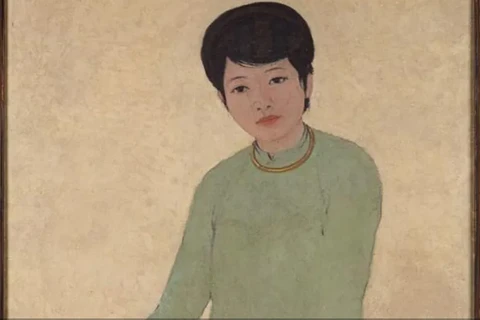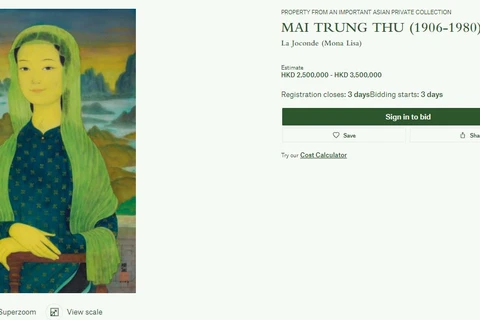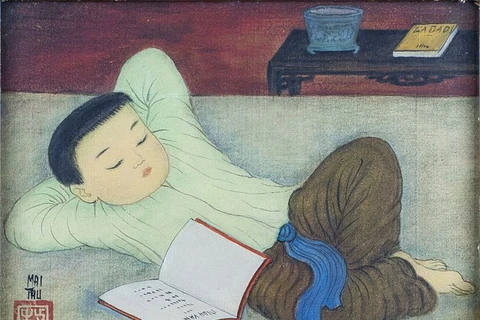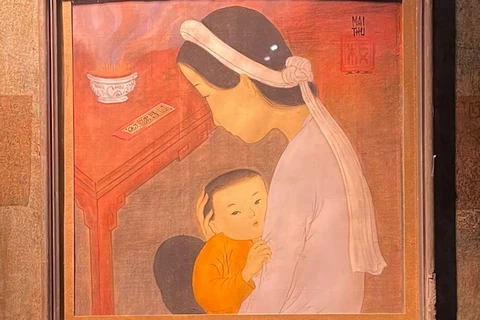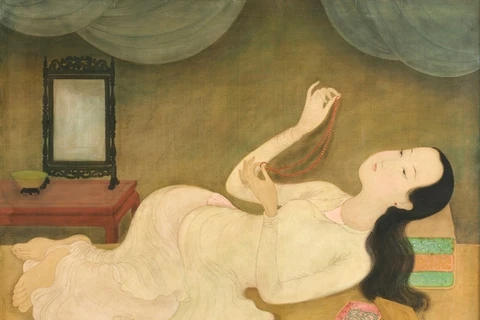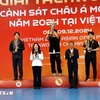 French researcher Charlotte Aguttes-Reynier (right) at her book launch in Hanoi. (Photo: Minh Thu/Vietnam+)
French researcher Charlotte Aguttes-Reynier (right) at her book launch in Hanoi. (Photo: Minh Thu/Vietnam+) Hanoi (VNA) - French researcher Charlotte Aguttes-Reynier (President of the Asian Artists Association in Paris) has recently presented a book entitled ‘Modern Art in Indochina’ (L'Art Moderne En Indochine) to the Vietnamese public. This book aims at providing her perspective and explanations on hindrances that have prevented the Indochinese art, an important part of the international art history, from reaching the audience.
On this occasion, Charlotte Aguttes-Reynier granted an interview for Vietnam News Agency to share her perspective after 10 years of studying Indochinese arts, as well as her journey to seek ‘million-dollar’ artworks by Mai Trung Thu, Le Pho, Le Thi Luu, etc.
- What has inspired you to study Indochinese arts?
Charlotte Aguttes-Reynier: Since I was a child, I followed by dad, who is the founder of Aguttes Auction House, to art museums and collectors’ private properties. My family moved to Paris, where arts were blooming. I was introduced to Oriental arts and Impressionism. Eventually, I’ve grown my interest in modern arts.
I’ve started studying Indochinese arts and Asian artists since 2013. From that point on, I’ve appraised and auctioned about 1,000 works of painting, lacquer and sculpture, including more than 115 works by Mai Trung Thu, about 150 works by Le Pho and nearly 100 works by Vu Cao Dam.
- You are both a researcher and an auctioneer. An auctioneer, on one hand, wants artworks to be sold at the highest price possible. A researcher, on the other hand, is required to be objective. Do you think your roles are conflicting with each other?
Charlotte Aguttes-Reynier: Let me tell you a story to answer your question. In 2014, I had the fortune of coming across Le Pho's masterpiece "Enjoying Tea," a magnificent silk painting of exceptionally high artistic quality. As deeply intrigued, I delved into in-depth research on this painting, the artist, and his career. I’ve discovered a profound passion in his paintings. Then I was surprised when finding out a significant disparity in auction prices in events organized in Asia and those in other parts of the world.
This painting deserved better recognition and that was what the Aguttes did. The price auctioned at the Aguttes surpassed previous estimates in Europe.
I felt an urge to brush away the veils of obscurity that had shrouded the artwork, bringing to light the art of Indochina and the talented artists of Vietnam.
In 2019, I founded the Association of Asian Artists in Paris with the aim of clarifying knowledge about the careers of artists with East-West cultures. Since then, my aspiration has been to create a work on Vietnam during the 1925-1945 period, hoping to illuminate the pivotal 20 years in the history of Indochinese art. This endeavor has culminated in the publication of the book "Modern Art in Indochina."
- Did the process of deciphering Indochinese art give you any surprises?
Charlotte Aguttes-Reynier: The focal point of my book revolves around the Indochina School of Fine Arts (L'Ecole Superieure des Beaux-Arts d'Indochine), established in 1924 by its inaugural French director, Victor Tardieu, in collaboration with the Vietnamese artist Nguyen Nam Son. Today, this institution stands as the Vietnam University of Fine Arts in Hanoi.
In my quest for information and original works, I meticulously explored the contributions of renowned Vietnamese painters across various epochs in the history of Indochinese fine arts. Figures such as Le Pho, Mai Trung Thu, Vu Cao Dam, Le Thi Luu, To Ngoc Van, Nguyen Gia Tri, and others have left an indelible mark on the artistic landscape.
One intriguing revelation surfaces in Le Pho's masterpiece, "White Comb." Despite the prevalent theme of symbolic women in Le Pho's body of work, "White Comb" stands out as an exception. The portrayal of the woman with only half her face visible serves as a compelling testament to the impact of Italian Renaissance aesthetics. This influence became pronounced after Le Pho's visit to Italy in the early 1930s.
Another noteworthy artist featured is Le Thi Luu, whose artistic approach distinguishes her from contemporaries. In contrast to the prevalent depictions of elegant women engaged in music or literature, Le Thi Luu injects a distinctive personal touch by portraying them in spring scenes or immersed in rice field labor. Her unique perspective adds depth and nuance to the artistic tapestry of the period.
Viligance required to distinguish between genuine and fake paintings
- What do you think about the current position of Vietnamese painting in the world?
Charlotte Aguttes-Reynier: I think that the works of French and Vietnamese artists attract almost equal numbers of collectors. Since about ten years ago, the works of artists who graduated from the Indochina School of Fine Arts have continued to set price records.
Works by the founders, teachers, and directors of the Indochinese School of Fine Arts, such as Victor Tardieu, Evariste Jonchère, or Joseph Inguimberty, are indispensable in collections, along with works by key artists who were trained by them, especially Le Pho, Nguyen Phan Chanh, Nguyen Gia Tri, Vu Cao Dam, Mai Trung Thu, etc.
According to our survey, the average annual growth rate in the sale prices of artworks by Vu Cao Dam, Le Pho, and Mai Trung Thu from 2000 to 2022 is 21%, 21%, and 26%, respectively. Growth was limited from 2000 to 2014, but from 2014, it increased significantly. By 2022, the total transaction value of their artworks exceeded 38.3 million euros, a substantial increase from the 4.2 million euros in 2014.
We are planning to organize an auction featuring artworks by Asian artists on March 7th in Paris.
- How do you assess contemporary Vietnamese art?
Charlotte Aguttes-Reynier: Contemporary Vietnamese art continues to garner attention and demand worldwide. However, the domestic art market still faces many challenges.
Firstly, most transactions currently take place in private circles, meaning buyers and sellers negotiate directly. There is a phenomenon where successful bidders sometimes abandon artworks without payment. Meanwhile, some sellers are not serious, providing fake certificates. The Vietnamese market shares similarities with the Hong Kong market, particularly in the prevalence of counterfeit paintings.
Secondly, in the digital age, buying and selling artwork has become a sustainable and transferable investment, akin to real estate. It is a thread that connects the past and reality. However, specific regulations in this regard are lacking in Vietnam.
Based on my experiences, I believe collectors need to stay vigilant, enhance their knowledge, and not rely on any certificates but rather on professional authentication.
We also have a solution for non-payment issues, which involves requiring a deposit when participating in auctions.
Thank you for your time./.




